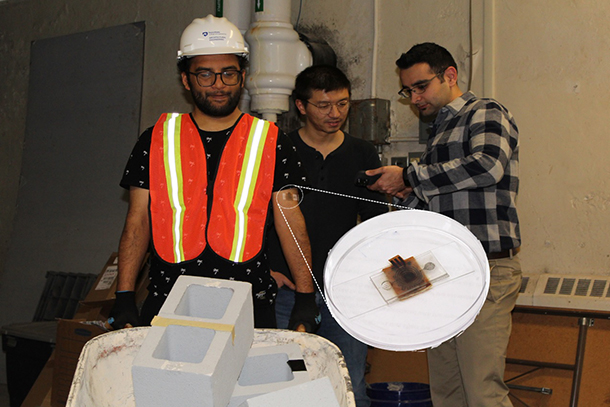
From left to right: graduate student Amit Ojha, The James L. Henderson, Jr. Memorial Associate Professor of Engineering Science and Mechanics Huanyu "Larry" Cheng and Assistant Professor of Architectural Engineering Houtan Jebelli examine the performance of the proposed flexible sensing mechanism. Credit: Provided by Houtan Jebelli. All Rights Reserved.
$1.8M NSF grant funds project to improve construction worker safety on sites
January 13, 2023
By Sarah Small
UNIVERSITY PARK, Pa. — With more than 1,000 fatal work injuries in 2020 and 169,200 nonfatal work injuries in 2021, construction workers face significant health and safety hazards on the job. A worker-centered holistic health monitoring approach could be a first step toward improving workplace health and safety on construction sites, according to Houtan Jebelli, assistant professor of architectural engineering and director of the Robotic, Automation, and Intelligent Sensing (RAISe) Lab. With a four-year, $1,800,000 National Science Foundation grant, Jebelli is leading a research team from Penn State and The Ohio State University to develop an artificial intelligence (AI)-enabled, real-time and context-aware holistic health monitoring approach for construction workers.
Jebelli said that while there are current health assessment tools, they have several drawbacks. Those assessments mostly rely on surveys, which he said can be too subjective and disrupt work. While there are wearable sensors, such as headsets that measure brain activity or wristbands that measure cardiac activity, there are not any sensors available that can record the multiple physiological signals together.
“We want to design and fabricate a flexible wireless sensing device that can capture workers' diverse physiological signals and biological markers to the stressors in the field and can be worn in a way that is non-invasive and non-disruptive to workers,” he said. “We also want to develop innovative machine learning algorithms and frameworks to infer meaningful cues from the elicited bodily responses for continuous and real-time assessment of workers' holistic health conditions. Importantly, we must also maintain workers' privacy.”
To maintain the privacy of workers, the researchers plan to develop a privacy-aware digital twin-assisted mechanism. A digital twin is a virtual replica of a system that is used for simulating or forecasting. This mechanism could both provide individual workers with personalized feedback on their health — for example, letting them know if they are becoming overheated so they can take steps to correct that — while also de-identifying the health measures from the individuals to create digital health maps that represent collective health information at a job site without compromising workers' privacy.
“The goal is to integrate the crowdsensing of workers' de-identified health measures and digital twin technology to generate a comprehensive health map of the construction workplace so that the safety managers get the aggregated health information of the job site,” Jebelli said. “To ensure workers' privacy, managers won't be able to identify the specific worker who is exposed to, for example, high physical fatigue. But they could identify the locations at the job site where stress is highest, or where workers are most fatigued, and then better identify the hazards of their job site.”
The researchers also plan to address signal noise — data points that are irrelevant and negatively alter the analysis — with their computationally efficient algorithms for real-time noise removal of signals in the field, which they say is lacking in the existing techniques.
“When we do physiological sensing for a subject at a hospital, for example, we can catch a high-quality signal in real-time because we can control the environment and subject’s movement,” Jebelli said. “But when you are doing physiological sensing in the field, we can not control the environment, and we cannot ask workers to stay in a stationary condition because movement is the nature of the job. High-intensity activity brings a lot of signal noise, and current signal processing methods are not robust in reducing such noise in real-time. We want to address this.”
Jebelli said that the research has the potential to be applied broadly.
“Our envisioned worker-centered health-monitoring mechanism based on advances in wearable sensor fabrication, predictive analytics and privacy-aware information visualization could be applied beyond the construction industry,” he said. “It could be used for the military, mining, manufacturing, professional athletes’ health monitoring and many other fields.”
The co-principal investigators on the grant are John Messner, Charles and Elinor Matts Professor of Architectural Engineering; Huanyu “Larry” Cheng, James L. Henderson, Jr. Memorial Associate Professor of Engineering Science and Mechanics; Mehdi Kiani, associate professor of electrical engineering; and Jennifer Graham-Engeland, associate professor of biobehavioral health, all at Penn State.



